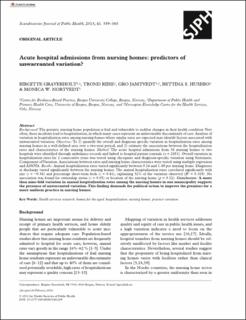| dc.contributor.author | Graverholt, Birgitte | |
| dc.contributor.author | Riise, Trond | |
| dc.contributor.author | Jamtvedt, Gro | |
| dc.contributor.author | Husebo, Bettina S. | |
| dc.contributor.author | Nortvedt, Monica W. | |
| dc.date.accessioned | 2021-10-25T12:45:31Z | |
| dc.date.available | 2021-10-25T12:45:31Z | |
| dc.date.issued | 2013 | |
| dc.identifier.citation | Graverholt, Birgitte, Riise, Trond, Jamtvedt, Gro, Husebo, Bettina S., & Nortvedt, Monica W. (2013). Acute hospital admissions from nursing homes: predictors of unwarranted variation?. Scandinavian Journal of Public Health, 41 (4), 359-365. | en_US |
| dc.identifier.uri | https://hdl.handle.net/11250/2825407 | |
| dc.description.abstract | Background: The geriatric nursing home population is frail and vulnerable to sudden changes in their health condition. Very often, these incidents lead to hospitalization, in which many cases represent an unfavourable discontinuity of care. Analysis of variation in hospitalization rates among nursing homes where similar rates are expected may identify factors associated with unwarranted variation. Objectives: To 1) quantify the overall and diagnosis specific variation in hospitalization rates among nursing homes in a well-defined area over a two-year period, and 2) estimate the associations between the hospitalization rates and characteristics of the nursing homes. Method: The acute hospital admissions from 38 nursing homes to two hospitals were identified through ambulance records and linked to hospital patient journals (n = 2451). Overall variation in hospitalization rates for 2 consecutive years was tested using chi-square and diagnosis-specific variation using Systematic Component of Variation. Associations between rates and nursing home characteristics were tested using multiple regression and ANOVA. Results: Annual hospitalization rates varied significantly between 0.16 and 1.49 per nursing home. Diagnoses at discharge varied significantly between the nursing homes. The annual hospitalization rates correlated significantly with size (r = −0.38) and percentage short-term beds (r = 0.41), explaining 32% of the variation observed (R2 = 0.319). No association was found for ownership status (r = 0.05) or location of the nursing home (p = 0.52). Conclusion: A more than nine-fold variation in annual hospitalization rates among the nursing homes in one municipality suggests the presence of unwarranted variation. This finding demands for political action to improve the premises for a more uniform practice in nursing homes. | en_US |
| dc.publisher | Scandinavian Journal of Public Health | en_US |
| dc.subject | health services research | en_US |
| dc.subject | homes for the aged | en_US |
| dc.subject | hospitalization | en_US |
| dc.subject | nursing homes | en_US |
| dc.subject | practice variation | en_US |
| dc.title | Acute hospital admissions from nursing homes: predictors of unwarranted variation? | en_US |
| dc.type | Journal article | en_US |
| dc.source.pagenumber | 359-365 | en_US |
| dc.source.volume | 41 | en_US |
| dc.source.journal | Scandinavian Journal of Public Health | en_US |
| dc.source.issue | 4 | en_US |
| dc.identifier.doi | https://doi.org/10.1177%2F1403494813482200 | |
| dc.description.localcode | måsjekkes | |
